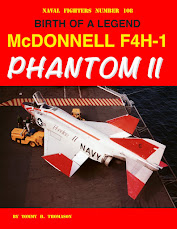The external appearance of the McDonnell F-4B changed in detail during its time in service. This is not a comprehensive list of the changes to a kit required to reverse it to the configuration when it was first deployed on Enterprise in 1962.
1. Early Bs did not have the slotted stabilizer: http://tailspintopics.blogspot.com/2011/09/f-4-flapstabilizer-change.html
2. Early Bs did not have the bump on the upper surface of the wing over the main landing gear strut or the doubler reinforcement plates on the lower surface of the wing.
3. Early Bs had the Mk 5 ejection seat; the difference in the top of the seat is apparent in any scale: http://thanlont.blogspot.com/2011/02/transition-to-martin-baker-ejection.html
4. The initial external drop tanks on the wing were a McDonnell design; the Navy subsequently procured the cheaper Sergeant Fletcher tanks with a constant-diameter mid section (statements reversing the identification of the source of the tanks are wrong): https://tailspintopics.blogspot.com/2014/02/f4hf-4-370-gallon-external-tank-redux.html
5. The total air sensor wandered around from the nose to the vertical fin and back: https://tailhooktopics.blogspot.com/2022/07/mcdonnell-f4h-total-air-temperature.html
6. Initially the only external antenna was on the nose landing gear door:
All the other bumps were added later.7. Deliveries of the IR sensor under the radome were behind schedule and the performance of the system when it was available, a disappointment, so it was usually not present, replaced by a cap.
When present, the portion immediately behind the dome was probably cylindrical rather than tapered as in the picture above.
The dome of the AN/AAA-4 sensor is reflective, essentially a mirror.
8. There were detail changes to the cockpit over time but with the exception of the top of the Mk 5 vs. Mk 7 ejection seat in any scale and the instrument panel/radar control in aft cockpit in 1/32, I doubt that they would be discernible by the casual observer. Bill Spidle provided the following illustrations for the Block 22 configuration (circa 1966), BuNo 152244 and subsequent, at least for a while:
Note that the radar scope in the rear cockpit retracted under the instrument panel and the black on either side of the upper part of the instrument panel were curtains (there was also one that blocked out light overhead).
9. One detail missed by most kit designers is that the aft bulkhead of the rear cockpit was never slanted. It was vertical (the compartment was not originally intended to be occupied) and the ejection seat rails were attached to the floor and the top of the aft bulkhead so as to be at the correct angle.
10, The wingtip lights:
For a more complete wingtip discussion, click HERE.









